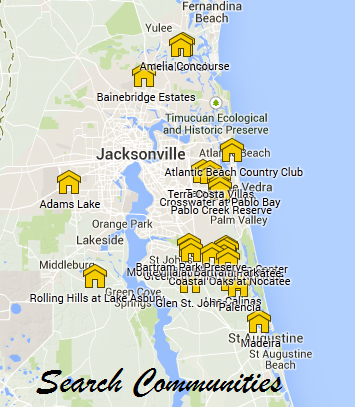Choosing the right neighborhood
 How can you choose the right community? Become a community “investigator”. Start with figuring out what you’re looking for, then do research and find a neighborhood that fits your needs. You don’t even have to wear a badge, trench coat, or a magnifying glass – but it couldn’t hurt to have them handy!
How can you choose the right community? Become a community “investigator”. Start with figuring out what you’re looking for, then do research and find a neighborhood that fits your needs. You don’t even have to wear a badge, trench coat, or a magnifying glass – but it couldn’t hurt to have them handy!
Step #1 – Profile Your Perfect Neighborhood
Before you start scrutinizing neighborhoods, turn the magnifying glass back on yourself.
Think about what you’re really looking for in a new neighborhood. Remember, perfection is difficult and you will most likely have to make some compromises, so put the “must-haves” at the top of your list and the “would- like-to-haves” at the bottom of your list.
Here are some things to consider that will help:
- What type of home do you want? Are you interested in a single-family home or an apartment, townhome
 or condominium? Choosing exactly what type of home you are interested is certainly critical.
or condominium? Choosing exactly what type of home you are interested is certainly critical. - How far are you willing to commute to work? Do you have a car or would you be willing to get one? Do you plan to drive, walk or take mass transit to work?
- Do you have children or are you planning to have children anytime soon? Even if you are a single person, living in an area with a sought after school system will typically raise your property value. Parents know that the first thing to do when looking at a neighborhood is to research the school system. If you have kids, you will also want to live in close proximity to community centers and parks.
- Do you want to be in a new development or a historic community? Historic neighborhoods have character, but often require lots of repair work and are governed by community associations with strict standards. Newer developments have more modern features, but are typically far from the city center.
- Think about what you do not want in a neighborhood. If you can’t stand late-night noise, you’ll probably want to steer clear of the college area or an area with a lively bar scene.
- What is your current community lacking? If you’re currently landlocked, but have always wanted to live on the waterfront, put that at the top of your list. If you’re a coffee junkie, having a coffee shop down the street may be a dream come true.
Step #2 – Zero In on the Area
If you’re moving within the same city, you may already know the various neighborhoods. Choose the ones that best match your list of wants. If you’re moving to a new city, you’ll have to do more research. Start by picking a part of town to search in. For instance, if your job is on the west side of town, start there. In a really large city, narrow it down to a few-block radius, say, SoHo in New York City. This will make your search more focused.
Step #3 – Get the Suspects
With your area of the city in mind, start digging up information. Find interesting neighborhoods online, ask local real estate agents for recommendations and compile all the background information you can, including:
- School information: Look into the local public and private elementary, junior and high schools, as well as daycare programs.
- Crime statistics: Most real estate sites have statistics that tell you how the zip code’s crime rates measure up to the national average. If you want specifics, call the local police station.
- Parks and recreation: How far is it to the closest park or recreation center?
- Neighborhood associations: Does the community you’re looking at have one, and, if so, are there lawn or construction restrictions? Is there a yearly fee?
- Tourist attractions: Get a guidebook or check out the convention and tourism bureau’s Web site to see all the city has to offer.
Step #4 – Find the Clues
Once you’ve done the investigative research, visit and walk around in the neighborhoods that seem to fit most of your needs. Use your senses to get a complete picture of the prospective community.
Sight –
- Visualize yourself in the neighborhood. Think of your daily routine. If you can’t live without a morning latte, is there a coffee shop nearby? Where will you walk your dog or go work out? You’ll enjoy the neighborhood more if it’s easy to do what you like.
- Remember your first impression. What do you notice first about the community? Are the houses well-maintained? Do the shops and restaurants look hip and inviting? Do the streets have curb appeal? You’ll want to feel good about where you call home, and impress buyers when you’re ready to move on.
- Make sure the local schools make the grade. Even if you don’t have kids, pay a visit to the nearby schools. High ratings are great, but seeing the buildings is much more telling. It will be easier to sell your house later if the schools receive high marks and are nice.
- Look for warning signs. Be on the lookout for signs that the neighborhood is in trouble. Are there a lot of “For Sale” signs or rentals?Do you see abandoned buildings or vandalism? If the community goes downhill, so does your house’s value.
- Observe the neighborhood at different times of the day. Driving through will help you get a snapshot of life in the community — good and bad. Are the streets well-lit at night? Are people using grills or decks in the evening? Are neighbors and kids socializing or do people keep to themselves? Do the roads turn into a parking lot after school or during rush hour? These visual clues can help you decide if you’ll fit in.
Sound –
- Talk to your future neighbors. Ask how they like the area, and get the dirt on anything they don’t like about the place. What do they want to change? What’s their favorite place to hang out? If they’re rude to you, they probably wouldn’t be good neighbors anyway.
- Talk to more people. You’ll get the best information from regular people who aren’t trying to make a sale. (Read: not your real estate agent.) Hit up your waiter at a restaurant for information when you’re checking out the local food, or ask a convenient store clerk to tell you what they know about the neighborhood.
- Stop and listen. Nature sounds are generally pleasant, but what about noise from the highway, airport, train tracks or nearby night clubs and bars? It’s not very relaxing to listen to trains screech by during your morning coffee, especially not on a daily basis.
Taste –
- No, I’m not asking you to lick your prospective home’s doorknob. But ask yourself if the neighborhood matches your personal taste in an environment. If the neighborhood meets your list but still feels wrong, search out another area. Trust your gut feeling — after all, you’re the one who has to live there. Just because it’s a nice neighborhood doesn’t mean it’s the one for you.
Smells:
- Specifically, are there any? You can’t experience unpleasant smells on the Internet and they’re not advertised in tourism brochures, but they can certainly affect your decision to live in an area. Take a big whiff of the air, and ask around if you smell any fishy (or just bad) odors.
STEP #5 – Find and home and close the Case
You’ve chosen your neighborhood. Now for the hard part: finding a house you love. Luckily, you’ve narrowed it down to a few streets. Now, make sure to:
- Find out how much house you can afford. The amount of money a lender offers you is often more than you can truly afford to pay. Be careful not to get in too much debt and be stuck with a payment you may not always be able to afford. Use a mortgage calculator to add all your current debts and see how much you can afford.
- Compare your loan options. Ask yourself these basic questions to find out what mortgage is right for you. Decide between fixed and adjustable rate mortgages with a mortgage comparison tool. Then, try another tool to see which loan term is best for you.
- Draw up your vision of home. It worked for your neighborhood — now think about what you want in a home. Write your own vision of home and stick to it while you’re house hunting. Don’t know a Craftsman home from a contemporary one? Learn about many different home styles and then find the right one for you.
- Find a qualified Realtor. It doesn’t cost you any extra to use a Real Estate expert to find the perfect house, so using an agent is critical in the home buying process. We would be more than happy to help with your home search, its what we do best. Don’t forget that we offer a 1% cash back rebate on any new construction home.
- Find the perfect house! Search for new construction homes using our map search on this website, or visit www.FirstCoastRE.com, the #1 Real Estate website in Northeast Florida.
Thinking about buying a new construction home? Let the new home experts at CashBackFlorida.com help you for FREE and get a 1% cash back home rebate on your new construction home purchase. Click here for details.

 |
 |
 |
This website is owned and operated by First Coast Realty Associates, a licensed Florida real estate brokerage company. Information in this post may not be completely accurate. Please seek legal and tax representation in legal and tax related matters. The owners of this website assume no responsibility for the accuracy of the content on this page.


